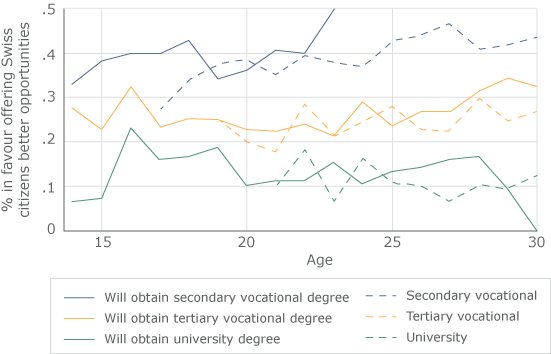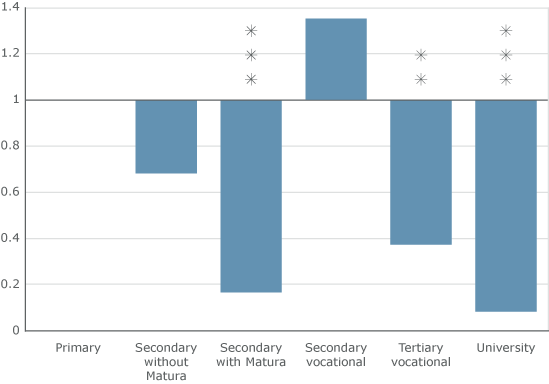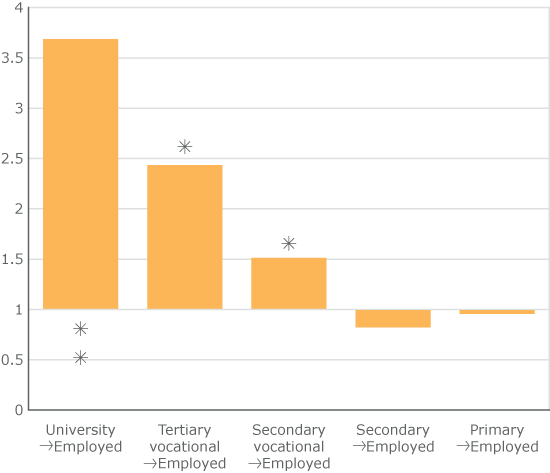Education is one of the most important determinants of citizens’ attitudes towards immigrants. Positive attitudes can be related to a liberalising effect from education, which fosters tolerance and egalitarian values, while negative views can be driven by the perception of so-called intergroup competition: when natives tend to feel threatened by the presence of immigrants, for example, in the labour market. To distinguish the underlying mechanisms of this relationship in Switzerland, Bram Lancee and Oriane Sarrasin tested two dimensions of education along the life course: how people’s attitudes change as they pass through education, and how these differ between individuals that have followed different paths.
The results of their study highlight the importance of making the transition into the labour market in changing attitudes toward immigrants: as higher educated people start working, they become more negative towards immigrants. The findings also show that attitudes do not significantly change as people pass through educational levels, suggesting that differences in attitudes develop early in life. But there are remarkable differences in attitudes towards immigrants by Swiss adolescents and young adults based on educational groups.
Attitudes change when entering the labour market
Lancee and Sarrasin found that while there are clear differences in attitudes towards immigrants by young Swiss people depending on educational group, they are fairly stable over time because these attitudes were already shaped during younger ages (Figure 1).
These analyses confirm that higher educated people tend to hold more positive attitudes towards immigrants: the odds of favouring Swiss citizens over immigrants are about 63% lower for young adults with tertiary vocational education than for those with primary education (Figure 2). The odds for university graduates are even lower (91.7%). But results also show an interesting deviation: the odds of favouring Swiss citizens for those with secondary education with a high school diploma are 83.3% lower compared with those of youth with only primary education.
The authors also test the impact of making transitions, both in education and the labour market, in the change of people’s attitudes towards immigrants. They found that attitudes do not shift from negative to positive or vice versa while young adults move along educational levels. There are significant changes, however, in the transition from different educational levels to entry into the labour market: when they become employed, young Swiss with a secondary or tertiary degree are more likely to favour Swiss citizens over immigrants (Figure 3).
In fact, the odds of favouring better opportunities for Swiss citizens rather than for immigrants are around 268% higher for employed university graduates if compared to when they were studying. The odds for tertiary and secondary vocational graduates are lower, but always positive at 2.4 and 1.5, respectively.
If attitudes towards immigrants differ among educational groups, but do not change during the period of life dedicated to education, such differences may reflect the importance of other factors, such as parental background, instead of a pure educational effect.

Figure 1. Percentage of young Swiss people that are in favour of offering better opportunities to Swiss people than to immigrants, by age and educational level.
Notes: The dashed lines represent attitudes of young people who already obtained the respective degree and solid line the attitudes of those who will obtain the respective degree at a later age.

Figure 2. Odds ratio of favouring Swiss citizens over immigrants for Swiss age 13-30 years old.
Notes: Primary education is the reference category. * p< 0.05, ** p< 0.01, and *** p< 0.001.

Figure 3. Odds ratio of transitions from educational levels to the labour market that favours Swiss citizens over immigrants for Swiss age 13-30 years old.
Notes: The first state of each transition is the reference category. * p< 0.05 and ** p< 0.01.
This Population Digest has been published with financial support from the Progress Programme of the European Union in the framework of the project “Supporting a Partnership for Enhancing Europe’s Capacity to Tackle Demographic and Societal Change”.